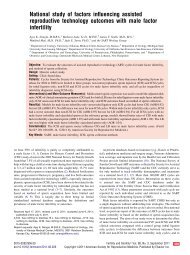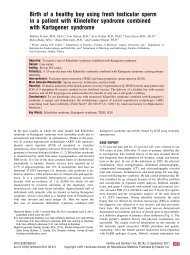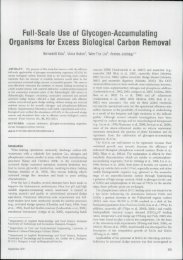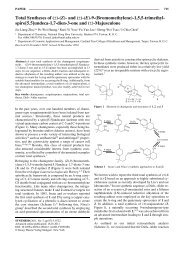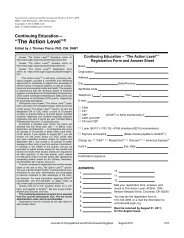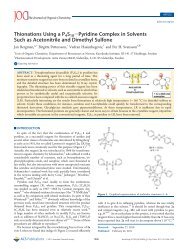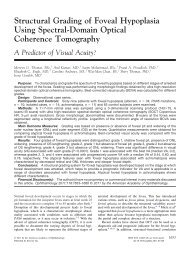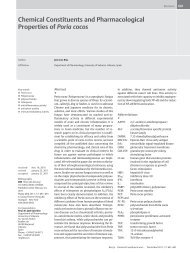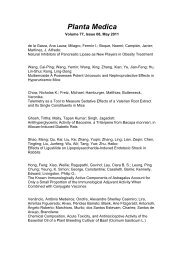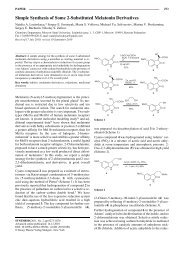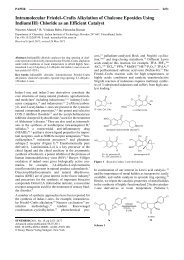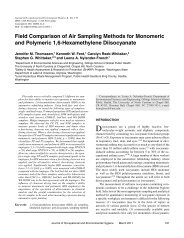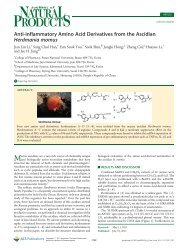Decreasing bleeding due to uterine fibroid with electroacupuncture
Decreasing bleeding due to uterine fibroid with electroacupuncture
Decreasing bleeding due to uterine fibroid with electroacupuncture
You also want an ePaper? Increase the reach of your titles
YUMPU automatically turns print PDFs into web optimized ePapers that Google loves.
CASE REPORT<br />
<strong>Decreasing</strong> <strong>bleeding</strong> <strong>due</strong> <strong>to</strong> <strong>uterine</strong> <strong>fibroid</strong> <strong>with</strong><br />
<strong>electroacupuncture</strong><br />
Yusuf €Ozgur Çakmak, M.D., Ph.D., a Ihsan Nuri Akpınar, M.D., b Tevfik Yoldemir, M.D., c and Safiye Çavdar, Ph.D. d<br />
a Acupuncture Program for Physicians and Department of Ana<strong>to</strong>my, School of Medicine, University of Yeditepe, Kayisdagi;<br />
b Department of Radiology, and c Department of Obstetrics and Gynecology, School of Medicine, University of Marmara,<br />
Pendik; and d Department of Ana<strong>to</strong>my, School of Medicine, University of Marmara, Haydarpasa, Istanbul, Turkey<br />
Objective: To report the usefulness of <strong>electroacupuncture</strong> (EA) for the management of menorrhagia <strong>due</strong> <strong>to</strong> submucous<br />
<strong>uterine</strong> <strong>fibroid</strong>.<br />
Design: Case report.<br />
Setting: University hospital.<br />
Patient(s): A 48-year-old woman <strong>with</strong> a symp<strong>to</strong>matic submucous <strong>uterine</strong> <strong>fibroid</strong>, who presented <strong>with</strong> severe<br />
menorrhagia.<br />
Intervention(s): Electroacupuncture.<br />
Main Outcome Measure(s): Doppler ultrasonographic assessment of <strong>uterine</strong> blood flow and number of pads used<br />
during menorrhagia.<br />
Result(s): Doppler ultrasound revealed decreased blood flow of the <strong>uterine</strong> artery <strong>with</strong> EA stimulation. With<br />
repetitive sessions of EA fewer pads were used during menorrhagia.<br />
Conclusion(s): We present the first human case in which decreasing <strong>uterine</strong> artery blood flow <strong>with</strong> EA improved<br />
menorrhagia <strong>due</strong> <strong>to</strong> <strong>uterine</strong> fibroma. Electroacupuncture could be a useful, alternative, and relatively noninvasive<br />
<strong>to</strong>ol for the management of <strong>fibroid</strong>s <strong>with</strong> menorrhagia as a severe complaint. (Fertil SterilÒ 2011;96:e13–5. Ó2011<br />
by American Society for Reproductive Medicine.)<br />
Key Words: Fibroid, menorrhagia, <strong>electroacupuncture</strong>, <strong>uterine</strong>, blood flow, myoma<br />
Uterine fibromas mostly occur in reproductive-age women, <strong>with</strong><br />
a frequency ranging from 20% <strong>to</strong> 25% (1). Surgical removal is the<br />
most common management for <strong>uterine</strong> <strong>fibroid</strong>s. If the patient is<br />
young and wants <strong>to</strong> bear children, myomec<strong>to</strong>my is the preferred option.<br />
However, after myomec<strong>to</strong>my there is the risk of <strong>fibroid</strong> recurrence,<br />
up <strong>to</strong> 50% in some series (2–4). Thus, one third of all patients<br />
are known <strong>to</strong> undergo reoperation for the treatment of <strong>uterine</strong><br />
<strong>fibroid</strong>s (5). Furthermore, myomec<strong>to</strong>my can lead <strong>to</strong> pelvic adhesions,<br />
which may inhibit future chances of conception. Hysterec<strong>to</strong>my<br />
is usually the last preference of those patients in cases of<br />
recurrence of fibromas after myomec<strong>to</strong>my.<br />
One of the most common symp<strong>to</strong>ms of submucous fibromas is severe<br />
<strong>bleeding</strong> (menorrhagia) during the menstrual cycle (6). For patients<br />
<strong>with</strong> a symp<strong>to</strong>matic <strong>fibroid</strong> and surgical risk, such as a his<strong>to</strong>ry<br />
of thromboembolic episodes, severe obesity, uncontrolled diabetes,<br />
and immunocompromised states, clinicians usually look for an alternative<br />
method of treatment. Uterine artery embolization is one of the<br />
various modalities available for the management of <strong>uterine</strong> <strong>fibroid</strong> as<br />
an alternative <strong>to</strong> hysterec<strong>to</strong>my (7). Magnetic resonance imaging–<br />
guided focused ultrasound surgery is a newer treatment option for<br />
women <strong>with</strong> <strong>fibroid</strong>s (8). Just like <strong>uterine</strong> artery embolization,<br />
Received February 22, 2011; revised March 23, 2011; accepted March 25,<br />
2011; published online May 11, 2011.<br />
Y. € O.Ç. has nothing <strong>to</strong> disclose. I.N.A. has nothing <strong>to</strong> disclose. T.Y. has<br />
nothing <strong>to</strong> disclose. S.Ç. has nothing <strong>to</strong> disclose.<br />
Reprint requests: Yusuf € Ozg€ur Çakmak, M.D., Ph.D., Department of Ana<strong>to</strong>my,<br />
School of Medicine, University of Yeditepe, Kayisdagi, Atasehir<br />
34725, Istanbul, Turkey (E-mail: cozgur@yahoo.com).<br />
focused ultrasound surgery also preserves the uterus. Percutaneous<br />
nerve stimulation or <strong>electroacupuncture</strong> (EA) shows a very selective<br />
action in increasing or decreasing blood flow of a target organ when<br />
the appropriate nerve and stimulation frequency combinations are<br />
used (9–11).<br />
Considering the positive results of transient ligation of the <strong>uterine</strong><br />
artery, we theorized that decreasing the blood flow of the <strong>uterine</strong> artery<br />
<strong>with</strong> EA may also have a positive effect for <strong>uterine</strong> <strong>fibroid</strong>s, especially<br />
those <strong>with</strong> menorrhagia. We present the first case study in<br />
the literature reporting the reduction of <strong>uterine</strong> <strong>bleeding</strong> <strong>with</strong> EA,<br />
in a woman <strong>with</strong> menorrhagia <strong>due</strong> <strong>to</strong> <strong>uterine</strong> fibroma.<br />
CASE REPORT<br />
A 48-year-old pale-looking woman presented <strong>to</strong> our center <strong>with</strong> a<br />
6-month his<strong>to</strong>ry of menorrhagia. Preoperative evaluation revealed<br />
a submucous myoma <strong>with</strong> intramural component extending 1 cm<br />
near <strong>to</strong> the serosa. The dimension of the myoma was 3 3 3.5<br />
cm on vaginal ultrasonography. Several techniques have been proposed<br />
for the treatment of such submucous <strong>fibroid</strong>s, most of them<br />
sharing the objective of producing an intracavitary protrusion of<br />
the intramural component. The observation of rapid migration of<br />
the residual intramural component of the <strong>fibroid</strong> <strong>to</strong>ward the <strong>uterine</strong><br />
cavity (12), <strong>with</strong> a parallel increase of myometrial thickness during<br />
hysteroscopic myomec<strong>to</strong>my (13), is the basis of excision of <strong>fibroid</strong><br />
by a two-step procedure.<br />
We preferred <strong>to</strong> remove the <strong>fibroid</strong> through a two-steps procedure,<br />
by means of traditional resec<strong>to</strong>scopic surgery, as originally<br />
0015-0282/$36.00 Fertility and Sterility â Vol. 96, No. 1, July 2011 e13<br />
doi:10.1016/j.fertnstert.2011.03.110 Copyright ª2011 American Society for Reproductive Medicine, Published by Elsevier Inc.
FIGURE 1<br />
Pre- and post-Doppler ultrasound measurements for right and left <strong>uterine</strong> arteries.<br />
Çakmak. Management of menorrhagia <strong>with</strong> <strong>electroacupuncture</strong>. Fertil Steril 2011.<br />
hypothesized by Loffer (12). First, surgical excision of the intracavitary<br />
portion of the <strong>fibroid</strong> by means of the usual progressive resec<strong>to</strong>scopic<br />
excision was done. This action must s<strong>to</strong>p at the level of the<br />
plane of the endometrial surface, so that the identification of the passage<br />
between the <strong>fibroid</strong> and the adjacent myometrial tissue is not<br />
impaired (cleavage plane). Once the cleavage plane was identified<br />
the usual cutting loop of the resec<strong>to</strong>scope was inserted in<strong>to</strong> the plane<br />
between the <strong>fibroid</strong> and myometrium, along the surface of the <strong>fibroid</strong><br />
(usually clearly recognizable by its smooth, white, compact<br />
surface), thus bringing about its progressive dissection from the myometrial<br />
wall. Between the strokes of the resec<strong>to</strong>scope, ‘‘hydromassage’’<br />
was performed <strong>to</strong> squeeze out the intramural portion of the<br />
submucous <strong>fibroid</strong> at its base (12). This was accomplished by rapid<br />
changes of intra<strong>uterine</strong> pressure using an electronically controlled<br />
irrigation and suction device (Endomat; Karl S<strong>to</strong>rz) (14). Indeed,<br />
by interrupting and restarting the supply of distension liquid several<br />
times, the maximum possible migration of the intramural component<br />
of the <strong>fibroid</strong> in<strong>to</strong> the cavity was obtained. Some parts of the<br />
intramural portion were left behind while avoiding perforation.<br />
Because the patient had persistent menorrhagia, pos<strong>to</strong>perative sonography<br />
1 month later revealed the persistence of some parts of the<br />
intramural component of the previous <strong>fibroid</strong>. Either repeat hysteroscopic<br />
surgery or vaginal hysterec<strong>to</strong>my was suggested <strong>to</strong> the patient<br />
after consideration of her age, but she refused it. She had been using<br />
oral contraceptives for severe menorrhagia for 2 months after the operation<br />
(September and Oc<strong>to</strong>ber 2010), during which symp<strong>to</strong>ms persisted.<br />
The patient suffered from side effects of the oral<br />
contraceptives and gave them up in Oc<strong>to</strong>ber 2010. She reported using<br />
45 pads in November and 48 pads in December 2010 during her<br />
menorrhagic periods. Finally she decided <strong>to</strong> have a hysterec<strong>to</strong>my<br />
1 month later, and she asked for an alternative method for the relief<br />
of menorrhagia while she was waiting for her scheduled surgery.<br />
We informed the patient about a possible noninvasive experimental<br />
technique: decreasing <strong>uterine</strong> blood flow <strong>with</strong> EA. She gave written<br />
consent before the EA session. Electroacupuncture was performed<br />
<strong>with</strong> Cefar Acus 4 (CefarCompex Accessories). We used SP6 (tibial<br />
nerve terri<strong>to</strong>ry) and ST29 (T12–L1 derma<strong>to</strong>mes terri<strong>to</strong>ry) (9) acupuncture<br />
points for electrostimulation <strong>with</strong> 80-Hz frequency and 180-microseconds<br />
wavelength (intensity of the stimulus started <strong>with</strong> 3 mA<br />
and increased up <strong>to</strong> 4.5 mA<strong>with</strong>out pain). Acupuncture was performed<br />
by a licensed and experienced (7 years) acupuncturist. Acupoint locations<br />
were confirmed by a Poin<strong>to</strong>select digital acupuncture point detec<strong>to</strong>r<br />
(Schwa-Medico), and single-use 0.20 13-mm sterile stainless<br />
acupuncture needles (Suzhou Kangsheng Medical Devices) were inserted<br />
relatively superficially (approximately 1 cm), sufficiently deep<br />
<strong>to</strong> stimulate sensory elements of the skin while remaining minimally<br />
invasive for patients. The blood flow <strong>to</strong> the <strong>uterine</strong> arteries was checked<br />
<strong>with</strong> a Doppler ultrasound scanner before and during the 15th minute<br />
of EA. Uterine blood flow parameters were measured by a color Doppler<br />
ultrasound scanner (Acuson Antares Premium edition; Siemens)<br />
<strong>with</strong> a 7-MHz transvaginal (endocavitary ) probe. The transvaginal<br />
probe was gently placed, and the <strong>uterine</strong> artery was detected. Doppler<br />
ultrasound measurements, before and 15 minutes after the EA, revealed<br />
that blood flow decreased in the <strong>uterine</strong> artery <strong>with</strong>in<br />
e14 Çakmak et al. Management of menorrhagia <strong>with</strong> <strong>electroacupuncture</strong> Vol. 96, No. 1, July 2011
15minutes.Thepulsatilyindexincreasedfrom3.44<strong>to</strong>3.55intheleft<br />
<strong>uterine</strong> artery and from 5.67 <strong>to</strong> 8.64 in the right <strong>uterine</strong> artery. Before<br />
EA the volume flow was 0.094 L/min in the left <strong>uterine</strong> artery, and it<br />
decreased <strong>to</strong> 0.080 L/min after EA. The baseline value of volume<br />
flow in the right <strong>uterine</strong> artery was 0.084 L/min and decreased <strong>to</strong><br />
0.055 L/min after EA (Fig. 1).<br />
For the following 6 days, EAwas used for 30 minutes daily. There<br />
was a decrease in blood flow of the <strong>uterine</strong> arteries and in the amount<br />
of menorrhagia. At the end of the menstrual period the patient<br />
reported using 28 pads.<br />
DISCUSSION<br />
In the present case we demonstrate that menorrhagia of a submucous<br />
fibroma could be decreased <strong>with</strong> EA. The Doppler ultrasound results<br />
revealed that <strong>uterine</strong> artery blood flow was decreased at both sides,<br />
and thereby <strong>to</strong>tal pad usage per menstrual <strong>bleeding</strong> decreased from<br />
48 and 45 pads <strong>to</strong> 28.<br />
Six <strong>to</strong> nine hours of bilateral <strong>uterine</strong> artery occlusion results in<br />
a 24% volume reduction of dominant <strong>fibroid</strong> and up <strong>to</strong> 42% reduction<br />
of menorrhagia symp<strong>to</strong>ms up <strong>to</strong> 6 months after <strong>uterine</strong> artery occlusion<br />
(15). Likewise, Istre et al. (16) also reported a case of dominant<br />
myoma volume reduction 3 months after the occlusion of <strong>uterine</strong> arteries<br />
for 6 hours. They reported 77.2% shrinkage in myoma volume,<br />
in addition <strong>to</strong> diminished menorrhagia symp<strong>to</strong>ms. Vilos et al. (15) reported<br />
42% relief of menorrhagia symp<strong>to</strong>ms, similar <strong>to</strong> our finding.<br />
Uterine artery embolization is another modality available for the<br />
management of <strong>uterine</strong> <strong>fibroid</strong> (7). However,amenorrhea(17) and<br />
loss of ovarian reserve (18) have been reported <strong>due</strong> <strong>to</strong> the full blockage<br />
of the blood supply <strong>to</strong> the ovaries during <strong>uterine</strong> artery embolization.<br />
Just like <strong>uterine</strong> artery embolization, MRI-guided focused ultrasound<br />
surgery also preserves the uterus (8). This procedure is performed<br />
while the patient is inside a specially crafted MRI scanner that allows<br />
doc<strong>to</strong>rs <strong>to</strong> visualize, locate, and ablate <strong>uterine</strong> <strong>fibroid</strong>s. Initial results<br />
<strong>with</strong> this technology are promising, but its long-term effectiveness is<br />
not yet known. This new technique needs experienced clinicians and<br />
ultrasound devices that can produce focused high-frequency, highenergy<br />
sound waves <strong>to</strong> target and destroy the <strong>fibroid</strong>s. Moreover, the<br />
technique may not be considered for claustrophobic patients.<br />
REFERENCES<br />
1. Brosens IA, Lunenfeld B, Donnez J. Pathogenesis<br />
and medical management of <strong>uterine</strong> <strong>fibroid</strong>s. London:<br />
Parthenon Publishing Group; 1999.<br />
2. Hana WM. Predic<strong>to</strong>rs of leiomyoma recurrence after<br />
myomec<strong>to</strong>my. Obstet Gynecol 2005;105:877–81.<br />
3. Fauconnier A, Chapron C, Babaki-Fard K,<br />
Dubuisson JB. Recurrence of leiomyomata after myomec<strong>to</strong>my.<br />
Hum Reprod 2000;6:595–602.<br />
4. Candiani GB, Fedele L, Parazzini F, Villa L. Risk of<br />
recurrence after myomec<strong>to</strong>my. Br J Obstet Gynaecol<br />
1991;98:385–9.<br />
5. Buttram VC Jr, Reiter RC. Uterine leiomyomata: etiology,<br />
symp<strong>to</strong>ma<strong>to</strong>logy, and management. Fertil<br />
Steril 1981;36:433–45.<br />
6. Camanni M, Bonino L, Delpiano EM, Ferrero B,<br />
Migliaretti G, Deltet<strong>to</strong> F. Hysteroscopic management<br />
of large symp<strong>to</strong>matic submucous <strong>uterine</strong> myomas.<br />
J Minim Invasive Gynecol 2010;17:59–65.<br />
7. Freed MM, Spies JB. Uterine artery embolization for<br />
<strong>fibroid</strong>s: a review of current outcomes. Semin Reprod<br />
Med 2010;28:235–41.<br />
8. Chen S. MRI-guided focused ultrasound treatment of<br />
<strong>uterine</strong> <strong>fibroid</strong>s. Issues Emerg Health Technol<br />
2005;70:1–4.<br />
Fertility and Sterility â<br />
9. Cakmak YO, Akpinar IN, Ekinci G, Bekiroglu N.<br />
Point- and frequency-specific response of the testicular<br />
artery <strong>to</strong> abdominal <strong>electroacupuncture</strong> in humans.<br />
Fertil Steril 2008;90:1732–8.<br />
10. Ho M, Huang LC, Chang YY, Chen HY, Chang WC,<br />
Yang TC, etal. Electroacupuncture reduces <strong>uterine</strong> artery<br />
blood flow impedance in infertile women.<br />
Taiwan J Obstet Gynecol 2009;48:148–51.<br />
11. Stener-Vic<strong>to</strong>rin E, Kobayashi R, Watanabe O,<br />
Lundeberg T, Kurosawa M. Effect of <strong>electroacupuncture</strong><br />
stimulation of different frequencies and<br />
intensities on ovarian blood flow in anaesthetized<br />
rats <strong>with</strong> steroid-induced polycystic ovaries. Reprod<br />
Biol Endocrinol 2004;26:2–16.<br />
12. Loffer FD. Removal of large symp<strong>to</strong>matic intra<strong>uterine</strong><br />
growths by the hysteroscopic resec<strong>to</strong>scope. Obstet<br />
Gynecol 1990;76:836–40.<br />
13. Yang JH, Lin BL. Changes in myometrial thickness during<br />
hysteroscopic resection of deeply invasive submucous<br />
myomas. J Am Assoc Gynecol Laparosc<br />
2001;8:501–5.<br />
14. Hamou J. Electroresection of <strong>fibroid</strong>s. In: Sut<strong>to</strong>n C,<br />
Diamond M, edi<strong>to</strong>rs. Endoscopic surgery for gynaecologists.<br />
London: W.B. Saunders; 1993.<br />
When appropriate nerve and stimulation frequency combinations<br />
are used (9–11), percutaneous nerve stimulation or EA shows a very<br />
selective action in increasing or decreasing blood flow of a target<br />
organ. We have previously demonstrated (9) that blood flow can<br />
be increased in the testicular artery of humans <strong>with</strong> EA by using<br />
a specific combination of stimulation frequency and a derma<strong>to</strong>me,<br />
using the effective frequencies that have been proven <strong>to</strong> increase<br />
blood flow in rats. Blood flow–decreasing parameters of electrostimulation<br />
have also been described in rats (11). It has been demonstrated<br />
that only high-frequency EA can decrease ovarian blood<br />
flow in rats; on the other hand, the neuroana<strong>to</strong>mical pathways that<br />
aid such a function consider central effects in addition <strong>to</strong> segmental<br />
innervation because the ovarian blood flow responses <strong>to</strong> highfrequency<br />
EA stimulation were also investigated after severance<br />
of the ovarian sympathetic nerves (11).<br />
Our case study has some limitations. First, the parameters for decreasing<br />
blood flow by EA have not yet been defined and optimized.<br />
Hence, the exact timing and spacing of treatment needs <strong>to</strong> be validated<br />
<strong>with</strong> further studies. Next, whether long-term intermittent EA would<br />
decrease <strong>uterine</strong> arterial blood flow parameters and cause long-term<br />
fibroma shrinkage for a longer duration has <strong>to</strong> be answered. Third,<br />
whether electrostimulation from the foot only (from the SP6 point)<br />
rather than the SP6 and abdominal points ST29 <strong>to</strong>gether is enough<br />
<strong>to</strong> decrease <strong>uterine</strong> blood flow has <strong>to</strong> be investigated, for possible further<br />
usage for <strong>bleeding</strong> during surgery. Last but not least, we performed<br />
EA for 6 days during the menstrual <strong>bleeding</strong> period.<br />
However, the frequency of the EA could be increased <strong>to</strong> twice daily<br />
or could be prolonged <strong>to</strong> days before the start of menstrual <strong>bleeding</strong>.<br />
It has been demonstrated that functional plasticity occurs for <strong>uterine</strong><br />
blood flow after repetitive EA, and blood flow can still be influenced<br />
after termination of repetitive EA sessions (19).<br />
In conclusion, we present for the first time in the literature a case<br />
study of management of menorrhagia <strong>due</strong> <strong>to</strong> fibroma <strong>with</strong> EA. This<br />
report is the first trial of EA for decreasing <strong>uterine</strong> artery blood flow<br />
in humans. We believe that the case presented here will be a step forward<br />
for new treatment options <strong>with</strong> the aid of EA-assisted blood<br />
flow reduction. Future randomized studies in large groups are necessary<br />
<strong>to</strong> confirm our finding and <strong>to</strong> optimize the parameters of the<br />
stimulation technique.<br />
15. Vilos GA, Vilos EC, Abu-Rafea B, Hollett-Caines J,<br />
Romano W. Transvaginal Doppler-guided <strong>uterine</strong> artery<br />
occlusion for the treatment of symp<strong>to</strong>matic <strong>fibroid</strong>s:<br />
summary results from two pilot studies.<br />
J Obstet Gynaecol Can 2010;32:149–54.<br />
16. Istre O, Hald K, Qvigstad E. Multiple myomas treated<br />
<strong>with</strong> a temporary, noninvasive, Doppler-directed,<br />
transvaginal <strong>uterine</strong> artery clamp. J Am Assoc Gynecol<br />
Laparosc 2004;11:273–6.<br />
17. Guo WB, Yang JY, Chen W, Zhuang WQ. Amenorrhea<br />
after <strong>uterine</strong> <strong>fibroid</strong> embolization: a report of<br />
six cases. Ai Zheng 2008;27:1094–9.<br />
18. Hehenkamp WJ, Volkers NA, Broekmans FJ, de<br />
Jong FH, Themmen AP, Birnie E, et al. Loss of ovarian<br />
reserve after <strong>uterine</strong> artery embolization: a randomized<br />
comparison <strong>with</strong> hysterec<strong>to</strong>my. Hum<br />
Reprod 2007;22:1996–2005.<br />
19. Stener-Vic<strong>to</strong>rin E, Waldenstr€om U, Andersson SA,<br />
Wikland M. Reduction of blood flow impedance in<br />
the <strong>uterine</strong> arteries of infertile women <strong>with</strong> <strong>electroacupuncture</strong>.<br />
Hum Reprod 1996;11:1314–7.<br />
e15



